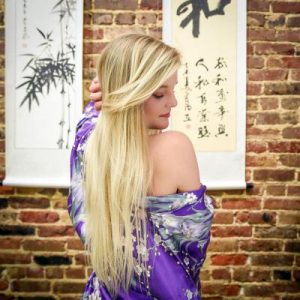Kimono and yukata have always been a symbol of the vibrant Japanese culture. These robes are not only comfortable to wear but also add a touch of elegance to your wardrobe. Here at Chopa, we receive lots of questions about kimono and yukata which is why we’re here to answer some more. So whether you’re looking to buy your first kimono or want to know more about their meaning, we are here to help.
Does color have any meaning with kimono?
Yes, the color of a kimono holds significant meaning. The most commonly known colors are red and white. Red is associated with good luck and is often worn during weddings or other celebrations. It also signifies strong emotions and power. White, on the other hand, symbolizes purity, innocence, and mourning. There are many other colors that convey different meanings, such as green, which represents growth and vigor, while blue signifies calmness. It is common to find a mix of colors as well.
Do the motifs and patterns on a kimono have any meaning?
Yes, every motif and pattern on a kimono has a specific meaning. For example, cherry blossom (sakura) is known to represent the beginning of a new life. Maple seeds (momiji) represent sound judgement. You can also find patterns such as cranes, which are a symbol of longevity and good luck. The dragonfly is considered to bring happiness and strength. These beautiful patterns are not just aesthetically pleasing, but also a reflection of the Japanese culture.
How much do kimono cost?
The cost of a kimono tends to vary significantly. It depends on the quality of the fabric, the intricacy of the design, and the availability of materials. A hand-sewn, silk kimono can cost you tens of thousands of dollars, while a more affordable option like cotton or polyester fabric can range from $50 to $500. However, at Chopa, we offer a range of choices that fit into any budget.
How do I wear a kimono?
Wearing a kimono can seem daunting at first, but fear not! The first thing you need to do is to put on the juban, an undergarment that covers your skin and makes it more comfortable to wear the kimono. Western culture often prefers a light undergarment like an undershirt and lightweight shorts or leggings. Then slip the kimono on, making sure the collar sits evenly at the back of your neck. Next, wrap the obi (a belt or sash) tightly around your waist, and tie it in a soft knot. Finally, adjust the length of the kimono and tie the obi in a bow. Voila! You’re now wearing your very own kimono.
How do I take care of my kimono?
Taking care of your kimono is essential if you want it to last a long time. On high end robes made of silk, we recommend spot cleaning using a mild detergent (Woolite) and a soft-bristled brush. For cotton robes, machine washing is possible in a cold water, delicate cycle. The cold water helps preserve the life of the kimono longer. As always, follow the instructions on the tag or ask the manufacturer for recommendations on how to care for your robe. If you do need to clean the entire garment, the manufacturer might recommend taking it to a professional dry cleaner who specializes in kimono and yukata.
The popularity of kimono and yukata has skyrocketed in the recent past, and it’s no wonder why. They exude an air of elegance and sophistication. and there are a wide variety of designs catering to different tastes. Whether you’re looking for a traditional pattern or a more contemporary design, make sure you know what they symbolize. And while kimono may have a reputation for being expensive, there are options available for every budget. If you’re looking to buy a kimono, Chopa has an extensive selection and is here to answer any questions that you may have. So go ahead, treat yourself to a beautiful kimono, and experience the elegance of Japanese fashion.
Tags: kimono yukata, women's yukata, yukata for men, yukata man








